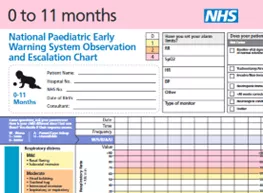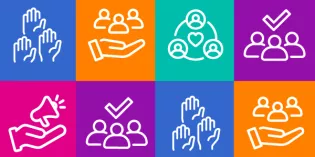
This blog was produced for the RCPCH Safety eBulletin.
Contributors:
- Tim Shearman, Improvement Advisor, Healthcare Improvement Scotland
- Dr Sonia Joseph, Strategic National Clinical Lead for Paediatrics and Neonatology, Healthcare Improvement Scotland
- Dr Thomas Bourke, Officer for Ireland at the RCPCH
- Dr Dana Beasley, Deputy Officer for Wales at the RCPCH
- Prof. Damian Roland, Clinical Lead for the System-wide Paediatric Observation Tracking (SPOT) programme
Paediatric Early Warning Systems (PEWS) are designed to effectively recognise and respond to the deterioration of children or young people in a healthcare environment.
Internationally PEWS has a long history, and there continue to be healthy debates about which parameters should be included, what the numbers should be, how staff and parental concerns should be included, its effectiveness and implementation.
Historically, members who moved or worked across different paediatric units raised concerns about why PEWS were different in different units; effective and appropriate standardisation has been a challenge for many years. Here we update members on the progress to appropriately standardise across UK nations.
Scotland
A standardised PEWS (Scotland) was launched 10 years ago and is now used in all 14 of Scotland’s territorial NHS boards. In 2023 the Scottish Patient Safey Programme (SPSP) Paediatric Programme launched a national improvement collaborative focused on improving the recognition, response, review and reassessment of deteriorating children and young people.
As part of the collaborative, teams are now focusing on their local improvement priorities relating to the reliable use of PEWS. This includes testing changes such as seeking and responding to the concerns of children, young people and their families and reliable processes relating to blood pressure derogation. Through this process, NHS boards are learning more about how the PEWS (Scotland) tool is being used and have provided useful feedback.
In parallel, Healthcare Improvement Scotland is reviewing the Scottish PEWS - this multiagency review will independently look at evidence and the experiences of children, young people, families, clinicians and strategic partners.
Northern Ireland
A regional Paediatric Early Warning Score has been in place throughout Northern Ireland for over a decade with children's wards and emergency departments using a standardised observation charts and system, with standardised information for families (PDF). After a period of implementation, training and audit, it is in routine use and well accepted by medical and nursing staff.
Over the last two years, a successfully transformation to an electronic version of the PEWS has taken place within the national electronic healthcare record [Encompass®]. A rules based escalation system within this electronic platform to automatically trigger an escalation in observations is under development.
Wales
The paediatric community in Wales will introduce a national Welsh PEWS in September 2025, adopting the English PEWS. Preparations have been underway with paediatric inpatient units familiarising themselves with the charts, completing e-learning, and teaching sessions for allied health professionals (AHPs), nurses and doctors.
An Acute Physical Deterioration Implementation network was established to support units, look at metrics for outcome measures and take conversations about escalation of care and “Call4Concern” (the Welsh version of Martha’s rule) further. The network is working with local implementation leads, the Child Health network and Quality, Safety and Improvement Wales. The Safe Care Partnership for Acute Deterioration is building on this work with a learning event in July.
England
In November 2023 the English National Inpatient Paediatric Early Warning System (NPEWS) was launched. The purpose of having a standardised observation chart was to create consistency in how deterioration in children is recognised, allow for unified training (starting at medical and nursing school) and reduce adverse outcomes.
Currently 60-70% of hospitals in England have implemented or have a route to implementation. Pilot phases have shown promising reduction in cardiac arrest rates in the test hospitals. As the roll out widens the team are learning more about the process of re-implementation. Re-implementation is also known as substitution, where an established medical practice is replaced by another similar one. There are some unique challenges to re-implementation which are different from de-implementation (the removal or decommissioning of an accepted practice). For NPEWS this is mainly about the impact of the transition from the way a hospital’s current PEWS records and responds to vital signs and observations.
In NPEWS, for example, low saturations always ‘score’, there is no exemption or adjustment for the child having an underlying cardiac condition. Consensus from the working group, a multi-professional group of specialists and generalists, was that these children in non-specialist environments do need to be highlighted as being at greater risk of decompensation secondary to their underlying condition. To avoid alert fatigue NPEWS is configured so that patients who stay in a low-risk banding (there are four bandings: low, medium, high and emergency) do not need to escalate if the nurse or doctor in charge are happy with their clinical condition. The net result being even if a child was scoring because of low saturations, if clinically appropriate for that child, one would not need to constantly escalate.
Learning from this implementation phase is that there is greater variability between hospitals in the number of children in medium and high categories than predicted. This learning is being actively used to look at escalation boundaries to improve the specificity of the PEWS system without allowing site specific differences, which defeats the purpose of a standardised system.
NPEWS already includes a parental concern trigger, which will lead to escalation of the child’s care regardless of other assessments, and facilitates a staff comment box to note shared concerns from carers/families. Future work is being undertaken to hear the voice of children and young people, to hear their concerns when they feel more unwell and need escalation in care.

Having laid the foundation with an in-patient chart, a pilot is underway to create an Emergency Department NPEWS chart prior to planned pre-hospital and community versions. A big transformation will be to align with Lord Darzi’s review of the NHS; the need to shift from analogue to digital. Although digital specification for NPEWS have been produced, hospitals are progressing at different speeds due to the complexities of digital providers and ability to update current systems. It is expected in England the requirement for all hospitals to have an Electronic Patient Record (EPR) by 2026 will be the driver to move to a completely digital NPEWS approach.
The possibilities for widespread implementation of big data approaches, combining artificial intelligence analysis, staff intuition, and most importantly children, young people and parental concerns, may become a reality.
These updates showcase a shared commitment to standardised care, informed adaptation, and ongoing collaboration between clinicians and parents and carers to strengthen our systems to ensure the safest possible care across the UK.










